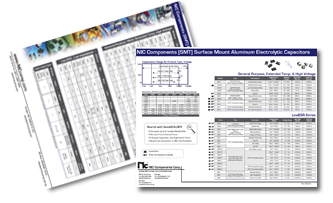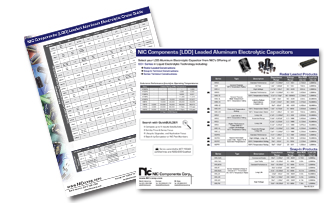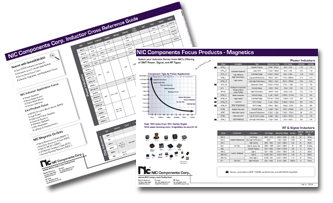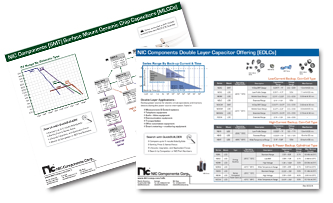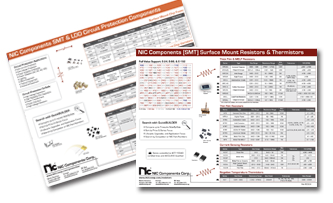Resources
Below you will find valuable information and tools for all of our products. Featuring general information for converters, FAQs, technical libraries of all our performance passive lines and a full environmental compliance section for all global regulations.


Performance Passives
Explore NIC’s product series by its market-leading performance passives categories.
Applications
Explore NIC’s product series by key market and application requirements.
Any questions? We're here to help.
Frequently Asked Questions
All products from NIC Components, today, are RoHS Compliant. Please refer to our Environmental Compliance page for more details.
ESR is an abbreviation for Equivalent Series Resistance, the characteristic representing the sum of resistive (ohmic) losses within a capacitor. While ESR is undesirable, all capacitors exhibit it to some degree. Materials and construction techniques used to produce the capacitor all contribute to the component’s ESR value. ESR is a frequency dependent characteristic, so comparison between component types should be referenced to same frequency. Industry standard reference for ESR is 100kHz at +25°C. Power dissipation within the capacitor, and the effectiveness of the capacitor’s noise suppression characteristics will be related directly to the ESR value.
E-Cap is an abbreviation for Electrolytic Capacitor. Electrolytic capacitors include Aluminum E-Caps (SMT and Leaded Types) and Tantalum E-Caps (link). E-Caps feature high capacitance value in relatively small component sizes. All E-Caps are polarized with anode (+) and cathode (-) terminals.
These terms essentially refer to the same thing… All of these terms (when applied to aluminum electrolytic capacitors) refer to the electrolyte composition. The use of a solid (polymer – organic semiconductor) electrolyte (in place of a more common liquid electrolyte) in aluminum electrolytic capacitors, results in improvements of greatly reduced ESR, higher ripple current ratings and extended operational life.
These terms (when applied to aluminum electrolytic capacitors) refer to the electrolyte type composition. The electrolyte acts as an electrical connection between the (-) cathode and the dielectric. Different forms (liquid – hybrid – solid) electrolytes have been developed over the years. Each type has benefits (PROS) and undesirable (CONS) characteristics. Development of better electrolytes has primarily focused on reducing the ESR and increasing the ripple current rating, by using higher conductivity materials. Improving the capacitor’s electrical characteristics over temperature (specifically at low temperature) and extending operational life have also been driving R&D in electrolyte development.
Standard tantalum electrolytic capacitors have a cathode of MnO2 (Manganese Oxide). Recently developed polymer type tantalum electrolytic capacitors have the MnO2 cathode replaced by a highly conductive polymer (polypyrrole). Polymer cathode tantalum electrolytic capacitors feature reduced ESR, higher ripple current ratings and suppression of combustion (improved safety factor) as compared to MnO2 cathode types.
Since 1982, NIC Components (NIC), in partnership with Nippon Industries Co. Ltd., has been a solutions provider in passive components to fuel the designs of technology and engineering organizations. As a leader in passive component technology, NIC’s offerings of passive components — including a wide range of capacitors, circuit protection products, mechanical components, magnetics, relays, resistors, RF products, and sensors — are built to meet the challenges of modern electronics design. But while who we are today will guide us into the future, NIC has built its business by staying at the cutting edge of technology, manufacturing the passives needed to support a future of innovation. Our strong foundation helps us support the engineers and designers of tomorrow’s technology through industry-leading reliability and performance.
For more information visit the About NIC page.
This Website is intended for use by NIC customers, potential NIC customers, NIC distributors and NIC personnel. Information provided covers NIC products and helpful tools. To request additional information, please contact NIC.
NIC uses industry standard 4 digit (YYWW) date code system (“0116” = 16th week of year 2001) on the majority of our products. Date code can be found on either the component packaging (reel or box) label or printed on the component itself. In the case of leaded aluminum electrolytic capacitors, the date code appears on the component sleeve.
Recommended storage conditions:
- Indoors
- Temperature: +5°C ~ +35°C (41°F ~ 95°F)
- Relative humidity: 40 to 75%
- Conditions outside these limits may adversely effect the packaging materials and/or the components’ solderability characteristics
Yes, NIC has ISO-9001:2015 certification from DQS Inc. For more information, please visit our certifications page.
NIC Sales Handouts & Promotions
| Column 1 | Column 2 |
|---|---|
SMT Aluminum Electrolytic CapacitorsLast Updated October 2024 |
LDD Aluminum Electrolytic CapacitorsLast Updated October 2024 |
SMT InductorsLast Updated October 2024 |
Double Layer Capacitors and MLCCsLast Updated October 2024 |
Circuit Protection and SMT ResistorsLast Updated October 2024 |

